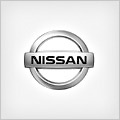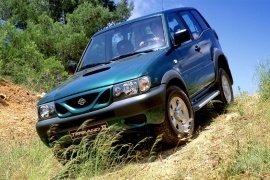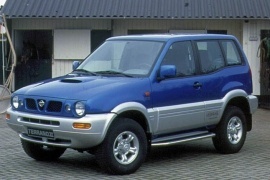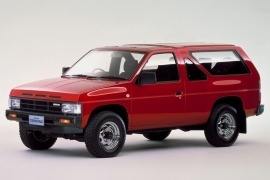
NISSAN Terrano 3 Doors
Generations Timeline, Specs and Pictures

The second generation of the European Nissan Terrano was introduced to the market in 1996 and it was a joint development program with Ford.
While the Ford Maverick was withdrawn, the Terrano II continued its journey on the market until 2006 in 3- and 5-door versions.
For the European version, the Nissan Terrano II received a body-on-frame platform, with a front independent suspension and a rear axle. It was not the hard-core off-road specialist as its bigger brother Patrol, but it was praised for its comfortable ride on pavement. Its handling was not its biggest advantage.
The exterior was compact, with rounded edges. The era of wedge-shapes was already gone. The Terrano II featured an ascending beltline with a step above the rear wheels. In 2002 it went through a final facelift that brought better engines and a steering wheel carry-over from the Nissan Primera.
Inside, the Terrano II was available with five seats, the last row being installed over the rear axle. There was not too much legroom for the passengers and no trunk space either. The dashboard featured a car-like layout, with a center stack and a high-mounted audio system.
Under the hood, there was the same 2.7-liter diesel engine, but a new, 3.0-liter unit was introduced. It was the same used for its bigger brother, the Nissan Patrol. All versions were part-time 4x4 with a low-range gear and the standard transmission was a 5-speed manual. Depending on the market, an option for 4-speed automatic was on the options list.

Nissan introduced another facelift for Terrano’s second generation in 2000, while Ford retired the Maverick from the market.
When Ford allied with Nissan to build an SUV together, it counted on the Japanese carmaker experience on building off-road vehicles suitable for the European roads. Thus, the twins Terrano II/Maverick started the production lines from Nissan’s factory in Barcelona in 1993. But as soon as the sales started, the customers stormed the Nissan’s showrooms while Ford was left behind. In 1999, Ford dropped the ball and retreat from the European SUV market. Once again, Nissan enjoyed the success and refreshed the car, making it ready for the Euro 3 Standards.
The refreshed version received a new front fascia, with a smiling slat on the grille. Nissan redesigned the front fascia and installed a new set of rectangular, Patrol-like lamps. The bumper received a black plastic upper section to cope better with bush scratches (or shopping carts). On its sides, the unpainted plastic molds from the wheel arches served the same purpose as before, while the side steps were real cart-stoppers and worked well on other people’s doors as well. The three-door version featured pop-out rear windows to help the rear passengers get some fresh air.
For the interior, Nissan introduced a multi-function steering wheel carried over from the Primera lineup. It offered a few extra buttons for the sound system. Like in the previous versions, the 2000 Terrano II with three doors offered an adequate room at the front and very limited in the back.
Under the hood, the gasoline version lost one pony due to the catalytic converter when compared to its predecessor. Nissan paired both engines with a five-speed manual and a transfer case with high and low gears. For more luxury, a four-speed automatic was on the options list.

After three years on the market, Nissan facelifted the second generation of the Spanish-built Terrano.
Just like its predecessor, the Terrano II was available with two body styles, with three or five doors. The vehicle was developed together with Ford, and both models, the Terrano II and its sibling Ford Maverick, were built in Nissan’s factory from Spain. Both carmakers updated their vehicles to comply with the Euro 2 norms, which were mandatory since January 1997.
From the outside, the main difference was at the front, where the car adopted four round headlights instead of the rectangular ones used on the previous model. Also, the grille got wider gaps to allow better cooling needed, especially in rough terrain. Depending on the trim level, the Terrano II featured plastic side moldings to protect the doors and panels from scratches and bush-markings.
Some visual changes were on the interior, where Nissan mounted a new dashboard and instrument cluster. Between the speedometer and tachometer, on top of the panel, the carmaker introduced an LCD for the odometer, while the fuel and temperature gauges were moved lower. An important addition was the airbag introduction for both front occupants. Nissan even tried to offer more comfort and luxury-inspired features such as the wood-trims on the center stack and door panels.
The car received a 125 hp 2.7-liter turbo-diesel engine on the technical side, which replaced the previously used 101 unit from the 1993 model. On the other hand, the 2.4-liter gasoline version lost six horses when compared to its predecessor.

With few changes having been made, the Terrano was the same reliable city/off-roader powered by the well known engine-trio comprised of the two 2.4 L and 3.0 L petrol units and 2.7 L Diesel. Despite the fact that none of the power plants were praised, they were still reliable and particularly smooth running in certain conditions. Terrano’s low-gear ratios and finely-tuned suspension made it a great car for adventuring. However, teh car was subjected to significant amounts of bodyroll when cornering and the steering was not a great helper either because of its lack of responsiveness.

Basically the same car as the Pathfinder, the small SUV was a good choice for various activities, from getting to work to hauling weights on country roads.
Although not as rigged as the Patrol, which still holds today the title of Nissan’s best off-roader, Terrano’s capabilities were not to be overlooked. Powered by a choice of two petrol units with capacities of 2.4 L and 3.0 L as well as a turbocharged 2.7 L Diesel unit, the Terrano was a rough terrain negotiator. The 6-cylinder 3.0 L plant produced 148 hp and 239 Nm of max torque at just 2200 rpm, providing sufficient pulling power for a car in its class.























































